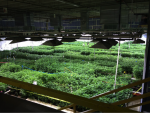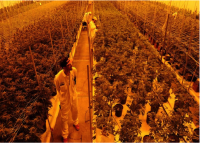Colorado regulators recalled roughly 65 batches of cannabis produced by two separate companies last Friday. Pesticide recalls plastered all over the news in the past few months have painted a picture of the cannabis marketplace to the public as unsafe and lacking crucial quality standards. The continued pesticide recalls in Colorado, along with poor safety standards in Washington, show the cannabis industry in an unfavorable light. The recalls include not only cannabis sold recreationally, but also medical cannabis, which should highlight a sense of urgency to deal with such a pervasive issue.
Because patients with weakened immune systems are seeking treatment with cannabis, it is the producer’s obligation to grow cannabis safely and without pesticides. That requires proper quality controls, pesticide use standard operating procedures, very robust lab testing and an overall push to protect consumer safety from both regulators and industry leaders.
The pesticides most commonly found in cannabis products include myclobutanil, a fungicide in Eagle 20, and avermectin, commonly found in Avid pesticides. The Pesticide Action Network lists both compounds as “bad actors” and as developmental or reproductive toxins.
Largely due to federal illegality, there are no EPA-approved pesticides for use in cannabis production, thus a lack of guidelines for states to follow in regulating pesticide use. As a result, states are working to write their own lists of approved pesticides.
Until very recently, Washington had no procedure for recalls of cannabis in place. “The LCB in Washington State has implemented emergency recall rules but more clarity on what types of pesticides are harmful is needed,” says Trek Hollnagel, co-founder of Dope Magazine and a chain of dispensaries in Seattle, WA. It is no secret that the Washington State Liquor Cannabis Board (LCB) poorly regulates cannabis labs.
Reports show immense variation in different labs’ results and rampant laboratory shopping. Dana Luce, co-founder of GOAT Labs, Inc., a cannabis-testing laboratory based in Vancouver, Washington, has been clamoring for a standardized recall procedure. “The state needs to take a much more proactive approach in monitoring laboratories,” says Luce. “Using blind testing or secret shoppers would give them the opportunity to catching those labs playing below board.” Luce also believes that retail outlets should absorb the cost of recalls, which could help prevent laboratory shopping just for higher potency test results.
In Washington, regulators rely on producers to self-report coupled with random inspections; furthermore they do not even require pesticide testing. Without a burden of proof placed on the producer or even the laboratory, it is hardly a regulated market.
Those producing cannabis with pesticides listed above should know they are violating the law. According to Comprehensive Cannabis Consulting (3C), “applying pesticides off label is a violation of state and federal law and could result in criminal and civil sanctions…”
In reality, the solution to this problem is not just a quick fix, but a multitude of corrective actions to move the cannabis industry forward. Nic Easley, chief executive officer of 3C, believes it starts with educating cultivators on using pesticides properly and good agricultural practices (GAP). “Many of the pest problems prompting the illegal use of pesticides are due to poor facility design, lack of cleanliness, over-fertilization and other general plant health issues,” says Easley. “All of those issues could be greatly reduced through education in GAP.”
Then comes regulator-industry collaboration, where all parties are constantly learning. “Regulators or independent third-party groups need to be performing on-site inspections, which cultivators need to participate in openly and transparently,” adds Easley. The Colorado Department of Agriculture (CDA) is actively working on this aspect by offering workshops aimed at helping producers get up to speed with worker protection standards.
“Adequate standards need to be applied across the board to labs, and ongoing proficiency testing needs to take place to ensure that a lab’s facility, processes and instruments are fully validated,” says Easley. So the problem is cannabis producers still using pesticides off label and if that continues, so will the recalls. It seems the solution involves industry-regulator collaboration, more robust laboratory systems and calibration methods and educating cultivators on good agricultural practices. Additionally, more state guidance is needed in the form of research for an approved list of pesticides on cannabis and a bigger push for regulation in the form of inspections and laboratory oversight.







